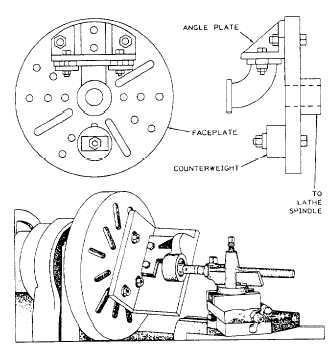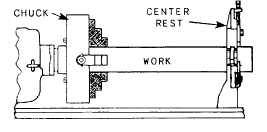Figure 9-24.—Work clamped to an angle plate.
angle, as shown in figure 9-24. Note the counterweight
added for balance.
For work to be mounted accurately on a faceplate,
the surface of the work in contact with the faceplate must
be accurately faced. It is good practice to place a piece
of paper between the work and the faceplate to prevent
slipping.
Before you clamp the work securely, move it about
on the surface of the faceplate until the point to be
machined is centered accurately with the axis of the
lathe. Suppose you wish to bore a hole, the center of
which has been laid out and marked with a prick punch.
First, clamp the work to the approximate position on the
faceplate. Slide the tailstock up until the dead center just
touches the work. (NOTE: The dead center should have
a sharp, true point.) Now revolve the work slowly; if
the work is off center, the point will scribe a circle on
the work. If the work is on center, the point of the dead
center will coincide with the prick punch mark.
Using the Center Rest and Follower Rest
Place the center rest on the ways where it will give
the greatest support to the workpiece. This is usually at
about the middle of its length.
Figure 9-25.—Work mounted in a chuck and center rest.
Ensure that the jaws of the center rest are adjusted
to support the work while allowing it to turn freely.
Figure 9-25 shows how a chuck and center rest are used
for machining the end of a workpiece.
The follower rest differs from the center rest in that
it moves with the carriage and provides support against
the forces of the cut only. Set the tool to the diameter
selected, and turn a “spot” about 5/8 to 3/4 inch wide.
Then adjust the follower rest jaws to the finished
diameter to follow the tool along the entire length to be
turned.
Use a thick oil on the center rest and follower rest
to prevent “seizing” and scoring of the workpiece.
Check the jaws frequently to see that they do not become
hot. The jaws may expand slightly if they get hot,
pushing the work out of alignment (when using the
follower rest) or binding (when using the center rest).
Holding Work in a Draw-In Collet Chuck
The draw-in collet chuck is used for very fine,
accurate work of small diameter. Long work can be
passed through the hollow drawbar. Short work can be
placed directly into the collet from the front. The collet
is tightened on the work by rotating the drawbar to the
right; this draws the collet into the tapered closing
sleeve. The opposite operation releases the collet.
Accurate results are obtained when the diameter of
the work is exactly the same size as the dimension
stamped on the collet. In some cases, the diameter may
vary as much as 0.002 inch; that is, the work may be
0.001 inch smaller or larger than the collet size. If the
work diameter varies more than this, it will impair the
accuracy and efficiency of the collet. That is why a
separate collet should be used for each small variation
or work diameter, especially if precision is desired.
9-16



